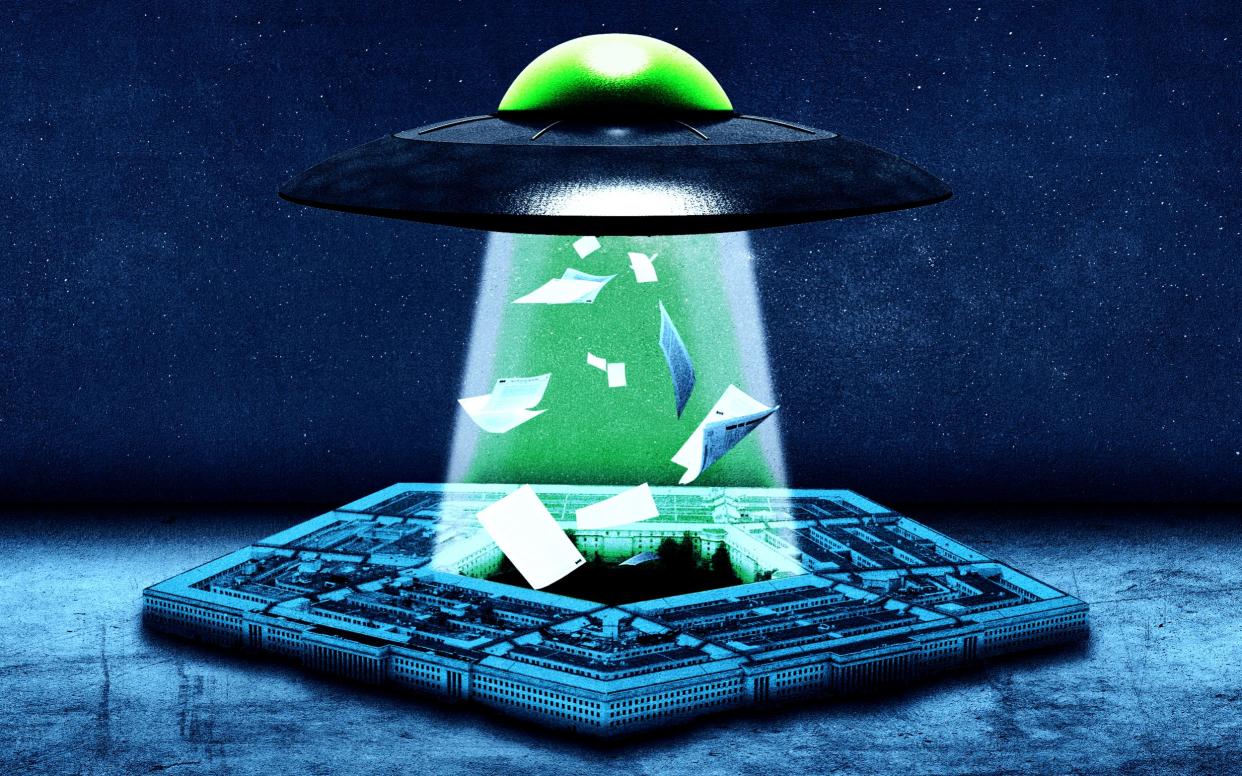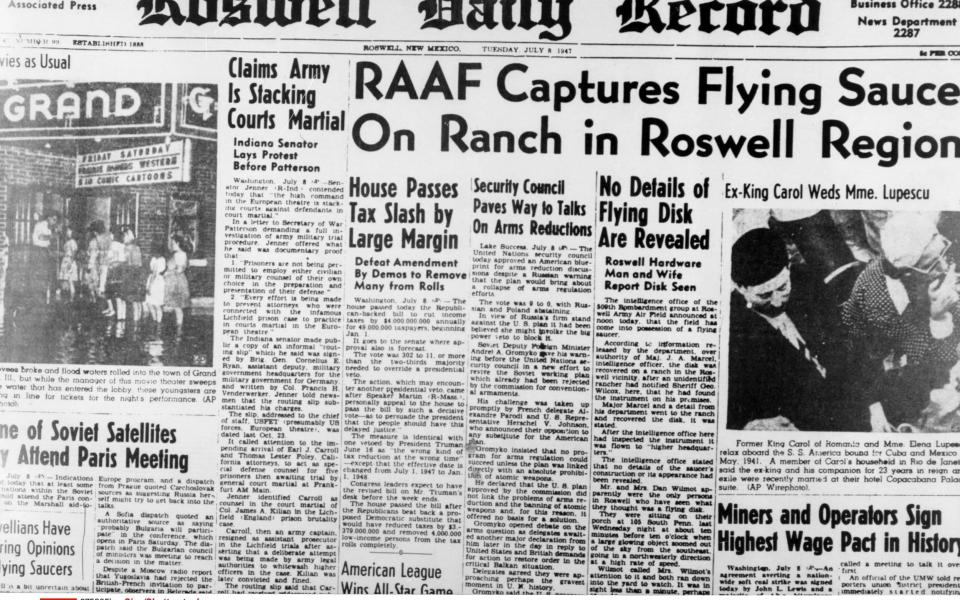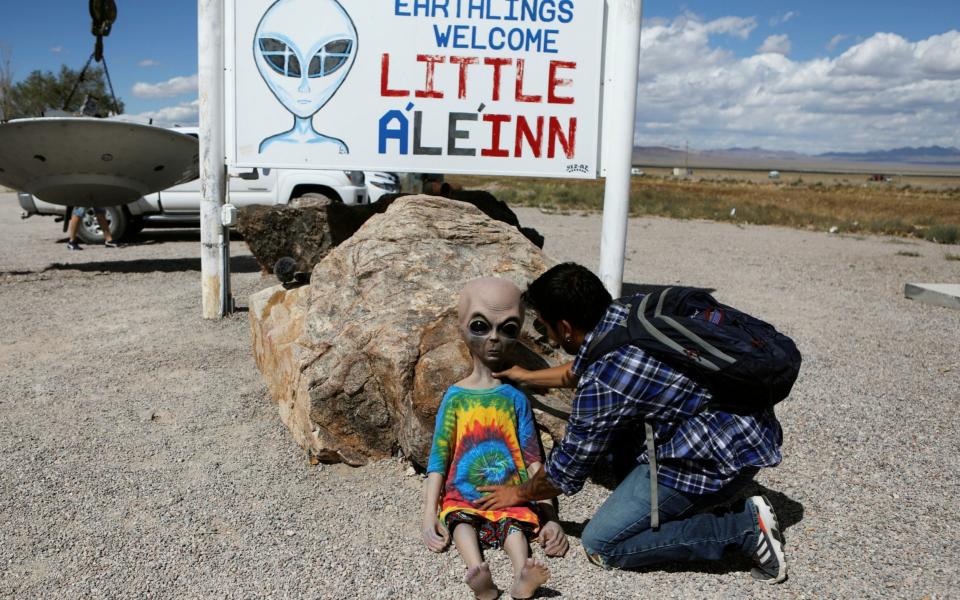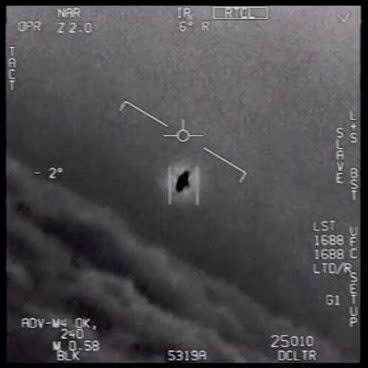The Pentagon thinks UFOs may exist after all... and the evidence is growing

Lieutenant Commander Alex Dietrich is, by her own admission, a highly rational person.
A US Navy fighter pilot who served combat tours in Iraq and Afghanistan, she has landed a supersonic F/A-18 jet on an aircraft carrier hundreds of times, and now teaches at the US Naval Academy.
She has also had one of the most famous close encounters with a UFO, or Unidentified Flying Object.
On November 14, 2004, Lt Cdr Dietrich was stationed off the coast of southern California on the USS Nimitz carrier, when numerous flying objects were picked up by ship radar - see the final silent clip in the video below.
The objects had descended impossibly fast, dropping a distance of 80,000ft in less than a second.
In separate planes, Lt Cdr Dietrich and Commander David Fravor were dispatched to investigate.
What they saw on that day has never been adequately explained – until now.
“Enter stage left, the Tic Tac– that’s what we affectionately refer to it as,” says Lt Cdr Dietrich, speaking publicly for the first time this week in an interview with 60 Minutes, the venerable US news programme.
Sunday, Lt. Cmdr. Alex Dietrich speaks publicly for the first time about an incident in 2004, known as the Nimitz Encounter. It was an example of “unidentified aerial phenomena” and acknowledged by the Pentagon. https://t.co/qD4qbmszcs pic.twitter.com/2KsvF8Lscz
— 60 Minutes (@60Minutes) May 14, 2021
“It jumped from spot to spot, and tumbled around in a way that was unpredictable. The whole time we’re on the radio with each other just losing our minds.”
Cmdr Fravor aggressively engaged one of the oblong objects, which he estimated to be 40ft in length, while Lt Cdr Dietrich adopted “high cover” above.
Then it disappeared.
Ship radar picked it up seconds later, 60 miles away. A third F/A-18 then caught it on an infrared camera: it looked like a giant white Tic Tac.
Lt Cdr Dietrich decided to go public with her story now – three years after Cdr Fravor – to reduce the “stigma” associated with UFO reports and, she says, to encourage other pilots to come forward without feeling “embarrassed or ashamed”.
Her testimony coincides with a growing acceptance among defence officials around the world that there may indeed be something “out there” – and that it might pose a genuine global security threat.
After decades of doing everything possible to keep reported sightings secret, there has been a sea change in how the Pentagon regards such sightings.

For starters, it no longer refers to them as UFOs – with their connotations of little green men – but to UAPs, or Unidentified Aerial Phenomena. Next month, Congress is to be given an unclassified report on evidence collected by the Pentagon’s UAP Task Force, the Office of Naval Intelligence and the FBI.
Ufologists - people who investigate UFOs - across the globe are hailing it as an unprecedented watershed moment in their long quest to uncover what the US government really knows – and they have former president Donald Trump to thank for it.
In December, when Mr Trump signed his mammoth $2.3 trillion coronavirus relief bill into law, it contained a little remarked upon clause requiring a full report on UFOs within 180 days, i.e. by June 25.
“We’re absolutely in new territory here,” says Nick Pope, who investigated UFO sightings while working as a British civil servant for the Ministry of Defence in the 1990s.
“What’s really elevated this is the sheer number, and position, of people now speaking out, saying we’re dealing with something that must be taken seriously," he added.
“When top guns, who don’t impress easily, get excited about the capability of these objects, their speed, manoeuvrability, trans-medium travel in water and air… that gets my attention.
"The pilot testimony is important, but there is so much more: radar data, infrared, measurement and signature intelligence… and we’ll get to see some of it.”
John Ratcliffe, director of National Intelligence under President Trump, raised anticipation when he hinted recently that there was “a lot” more information than the public currently knows.
He said he had seen satellite imagery of objects “frankly engaging in actions that are difficult to explain”, and incidents of them breaking the sound barrier with no sonic boom.
Former president Barack Obama – who has long joked in interviews that he knows things about “aliens” that he cannot talk about – this week echoed that sentiment during an interview with James Corden.
“What is true – and I’m actually being serious here – is that there’s footage and records of objects in the skies that we don’t know exactly what they are," he said. "We can’t explain how they moved.”
The United States’ long history of UFO sightings began in earnest on June 24, 1947 when Kenneth Arnold, an amateur pilot, reported seeing nine objects flying near Mount Rainier in Washington state. Newspapers at the time coined the term “flying saucers”.
The following month, a farmer found wreckage on a ranch near Roswell, New Mexico. In a press release, the US military called it a “flying disc”, but later said it was part of a weather balloon.

Regardless, a decades-long conspiracy theory was born.
By the 1950s, the US Air Force was being inundated with UFO reports from the public. One of the most notorious was the so-called “Invasion of Washington” in 1952, when numerous sightings were made over the capital in a two-week period.
It was the Cold War, and the CIA, fearing mass hysteria could play into the hands of the Soviet Union, worked to debunk sightings and infiltrate UFO-hunting groups.
Project Blue Book, a US Air Force unit, was set up to analyse thousands of sightings – but, in 1968, a 1,485-page government report written by physicist Edward Condon concluded that there was nothing of interest.
“Further extensive study of UFOs probably cannot be justified,” it said.
For decades afterwards, anyone who reported seeing something strange in the sky was considered a crackpot – even leading lights in the US military.
However, there remained a few highly influential figures who believed a mystery was there to be solved. The most powerful among them was Senator Harry Reid, the Democrat leader in the US Senate from 2005 to 2017.
Mr Reid represented the state of Nevada – home to Area 51, the highly classified US Air Force base which has been the subject of many UFO conspiracy theories and Hollywood films.

In 2007, Mr Reid managed to push through Congress, clandestinely, $22 million in “black ops” funding for a new department. It was innocuously named the Advanced Aerospace Threat Identification Program (AATIP).
From a fifth-floor office deep inside the Pentagon, a real-life X-Files team studied hundreds of reported UFO sightings – including the USS Nimitz “Tic Tac” incident from 2004.
The department was led by Luis Elizondo, a career intelligence official who later resigned because he felt his findings were not being taken seriously enough.
Shortly after his departure in late 2017, Mr Elizondo told the Telegraph how his team established geographical “hot spots” for sightings, sometimes near nuclear facilities, and common ways in which UFOs moved.
“We began to see trends and similarities in incidents – very distinct observables. Extreme manoeuvrability, hypersonic velocity without a sonic boom, speeds of 8,000mph. A lot of this was supported by radar signal data, gun camera footage from aircraft, multiple witnesses.”
He said he came to a “realisation that these are probably not any type of aircraft in any national inventory. I think it’s pretty clear it’s not us. So one has to ask the question where they’re from.”
He also added: “There was never any display of hostility.”
A key moment in the UFO debate – and whether it should be taken seriously – came in 2017 when the New York Times published the infrared video of the “Tic Tac” sighting. Ufologists felt vindicated, not least because it proved the Pentagon had seen fit to investigate the incident.

Today, thanks to lockdown – which provided a dramatic reduction in light pollution coupled with an army of people with empty evenings on their hands – supposed UFO sightings have proliferated around the globe.
In the UK alone, reports of suspected alien spacecraft doubled last year.
And once-secret intelligence just keeps coming. Last month, footage of bizarre images of flashing pyramid-shaped UFOs was posted online, which the Pentagon confirmed was taken in 2019, by a US Navy ship off California.
The US Navy photographed and filmed “pyramid” shaped UFOs and “spherical” advanced transmedium vehicles; here is that footage.
Please visit my Instagram and https://t.co/5JMYxoo9sI to read all the details that I can share at this time. pic.twitter.com/58CXZ1ljAF— Jeremy Corbell (@JeremyCorbell) April 8, 2021
Another leaked video, taken from a fighter jet in 2015, showed a small object moving at tremendously high speed just above the water off Virginia on the US east coast. Pilots could be heard yelling: “Oh my gosh, dude” and “Wow! What is that, man? Look at that flying!”
In another incident, pilots reported seeing an object that looked like a cube inside a sphere flying between their aircraft, which were barely 100ft apart.
Many of these incidents are expected to be further detailed in next month’s report. But even though it will be “unclassified”, it's still unclear exactly how much will come out.
“I expect a very drone-heavy narrative,” says Mr Pope, the former British civil servant.
“I don’t expect it’ll plunge into extraterrestrial visitation. If there is anything really juicy, it will probably be in the classified annex. Governments are just nervous and reluctant to say ‘We don’t know...’ because it makes them look weak and ineffective.
“But that may be the position we’re in.”
Do you believe UFOs exist? Share your views in the comments below

